Removal of a stripped screw with hand drill.
You have already made the guide/ pilot hole by stripping the screw so centering the bit should be fairly easy.
Just remember it isn't at 90 degree and you need to angle the drill some if you are going to remain centered.
A 7/64 bit will cut the head off.
In the past I have had good luck in that I've always managed to step down two sizes with the drill bit and when the smaller bit grips/grabs/bites the screw it has turned/spun/threaded out the bottom. EZ PZ. Not so with this one. I think maybe the factory worker "staked" this one twice and the other screw (came reallllly easy) not at all.
The drill bit sizes I have to work with are 7/64 (will remove threads) 3/32, 5/64 and 1/16.
Step down one and you had better be sure of a steady hand. ANY deviance from center and you are taking off threads.
Step down to the smallest and any extra applied force will bend the bit and force it off center. They call it whipstocking or directional drilling in the oilfield.
Using the 5/64 bit and going SLOWLY with a light applied downward pressure I had to drill almost completely through the screw shaft before it bit enough to spin the shaft/shank out the bottom. Still got off center some and took threads on a small portion. Notice there only two threads left and I would have gone completely through.
All ended well. The new screws tighten on the bar/shaft and didn't strip so with the new screws and seals I'm calling one done.






